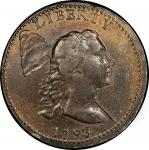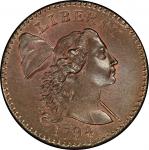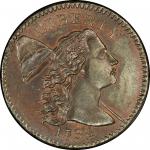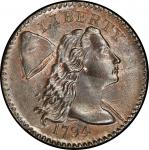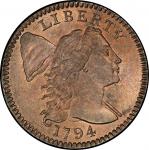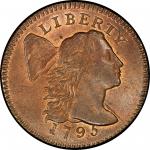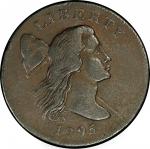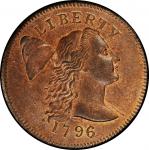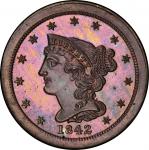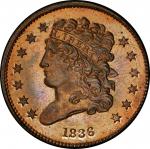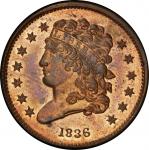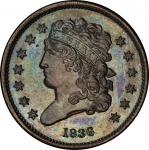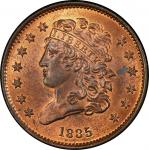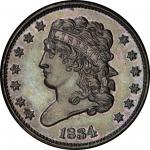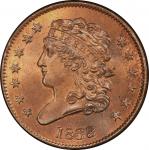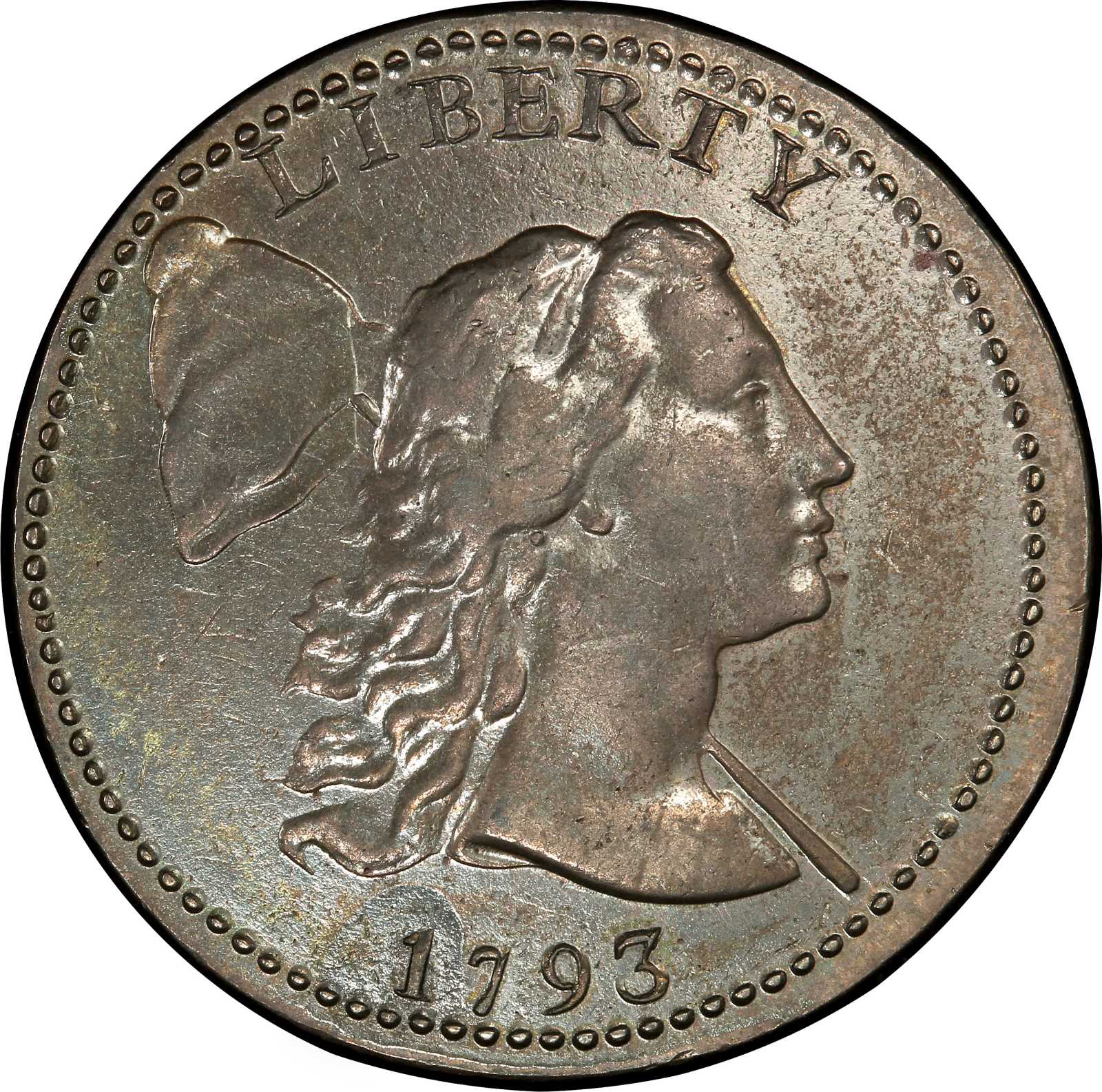The finest cent of this variety I have ever seen. - W. Elliot Woodward, 1867One of the finest examples extant of the 1793 Liberty Cap cent, this piece beautifully showcases Joseph Wrights elegant and distinctive portrait bust. Showing little or no wear, the relief of the portrait is boldly rendered, just a bit soft above Libertys ear but ably depicting the expressive profile that defines this beautiful obverse. The surfaces are dark olive and steel, with some lustrous medium brown outside the beaded borders. Applied gloss is faintly present across both sides, old enough to blend into the fields and design recesses quite naturally but retaining some traces of nearly invisible prismatic highlights; it is chiefly visible where it has thinned in the fields and at the base of Libertys bust. The scattered light marks in the field are typical of the variety, suggesting most or all predate striking. Similar marks are present on the Eliasberg specimen from these dies. A single tick in front of Libertys lower lip is noted, as are a few shallow contact points amidst the top of Libertys hair and forehead, but most other putative marks are pre-striking or lintmarks produced at the moment of striking. The reverse shows very few marks of any sort, though a pair of microscopic pits is hidden between the right ribbon end and the lowest leaf cluster on the right side of the wreath. A dark halo around 1 of the date appears unchanged since this coin was plated in 1949; it was the chief identifying feature described when this coin appeared on an invoice from Burdette G. Johnson to collector Arthur Gray in August 1943.The obverse is trivially misaligned, with a slightly larger area outside the beads on the right side than seen on the left. The reverse centering is ideal, suggesting this was the lower die. Called Die State I in the Breen blue book, this cent shows evidence of what will develop into a "faint reverse bulge slanting up to the right between NT" in Breens Die State II. The bulge on this coin is slight, extending from the left side of the right loop of the ribbon bow, beyond the lower right serif of N of CENT, to the left flag atop the nearby T. The granularity seen around ONE CENT is also present on the Mint State Eliasberg coin, confirming that this texture was on the die face and is not unique to this specimen. The die state is early enough, and the strike is crisp enough, to see a batch of lapping lines connecting the base of the Liberty cap to Libertys hair, directly above the pole, and a few individual lines created in the same manner on the caps base below the pole. A few others are hidden in Libertys hair, including one behind her ear and two more parallel lines seen at her hairline above her forehead. Unlike most coins struck from later die states, this specimen shows ONE CENT boldly defined at the central reverse.As with many important cents that were guardedly traded among a small group of connoisseurs for most of the interval following removal from circulation, this coins provenance is difficult to entirely pin down. The published provenance of this cent has shifted several times in the last few decades. The highlights remain the same, staked out with documentary evidence, while determining intermediate ownership is sometimes reliant upon assumption or its stepbrother, tradition. It is unquestioned that this coin was owned by New York collector L. Bayard Smith when the Crosby-Levick article on 1793 cents was published in the April 1869 issue of the American Journal of Numismatics. His name, as well as a note that he got it "from the Mickley sale, at $55," is included in the text that accompanies the Levick plate, one of the legendary images in the history of American numismatics, which depicts this very coin. A decade later, the Levick plates position in history was already secure, as Ed. Frossard wrote in his 1879 monograph on large cents that "Messrs. Levick and Crosby, when they compiled their plate illustrating the cents of 1793, had all the fine specimens from the best cabinets in the country sent them for examination."The provenance can, with a speculative 50/50 shot, be taken back even further than the 1867 sale of the Joseph J. Mickley Collection, to the very beginnings of serious interest in cent collecting. In an article titled "Walts S-13" in the March 2008 issue of Penny-Wise, Jim Neiswinter suggests "I think there is a good chance that Mickley got this 93 Cap from Edward Cogans first sale on November 1, 1858." Mickley owned two 1793 Liberty Cap cents, sold as lots 1933 and 1934 in the W. Elliot Woodward sale of October 1867. Lot 1933 was this coin, described as "entirely Uncirculated, polished surface; the finest cent of this variety that I have ever seen." It sold for $55. The other was a specimen of what is known today as Sheldon-14, described as having a "cracked die" but "fully equal to the last in impression and condition." That coin sold to Richard B. Winsor for $37.50 and likewise appeared on the 1869 Levick plate. One of these coins was undoubtedly the one Mickley bought for $7.50 from Cogans first sale. Mickley bid on five coins in the sale (conducted through sealed submitted bids that were opened on the assigned day in Cogans Philadelphia shop), and won four of them. The 1793 Liberty Cap was the second most expensive coin sold, but we may never know if it was Mickleys S-13 or S-14.After this coins appearance on the Levick plate in 1869, the trail grows somewhat cold. Smith was an active collector for most of the late 19th century. He was one of two named consignors to Ed. Frossards sale of March 1888, but the sale contained large cents that were mostly inconsequential; this coin was not among them. Smith retired to Morristown, New Jersey from New York City sometime between 1891 and 1895; the New York Times reported the sale of his four-story brownstone at 104 E. 38th Street in the May 17, 1898 issue, perhaps marking the end of his life as an even temporary city dweller. He died in Morristown on April 19, 1916. Smiths fine collection of medals depicting George Washington is known primarily, even exclusively, from an unpublished inventory Smith composed about 1900; the inventory was sold in the June 2004 George F. Kolbe sale of the John J. Ford, Jr. library, where the cataloger reported that Smiths Washingtonian collection was "purchased en bloc in the late 1930s by F.C.C. Boyd." Though no invoice including the Smith Washingtoniana is among the Burdette G. Johnson invoices of material from the Virgil Brand Collection archived by the Newman Numismatic Portal, it seems likely that Smiths entire post-1888 collection, including this coin, was acquired at some point by Virgil Brand.In 1943, this coin turned up among the remnants of Virgil Brands remarkable hoard. The fertile Burdette G. Johnson archives provide the first documentary appearance of this coin since it was published in the American Journal of Numismatics in 1869. Arthur L. Gray, a druggist from Saginaw who continued to collect even after he consigned a superb collection to the February 1939 J.C. Morgenthau & Co. sale, was sent this coin on August 23, 1943. Johnsons terse but definitive description leaves no doubt of the coins identity: "1793 U.S. Cent. Liberty cap. Unc., purplish, slight spot on figure one of date." It was priced at $400 net, indicating no discounts would be given. While some of Johnsons invoices indicate that certain coins were paid for or returned, this one shows no such notes. Any assumption that the coin was actually acquired by Gray is just that, but at a minimum this document proves that the coin was in Burdette Johnsons hands when he was selling coins from the Brand Estate. One version of the Bland census posits that this coin sold to Gray and then appeared in the Celina Coin Companys fixed price lists 11 and 12 of 1944 and 1945, but the description in the Celina firms lists ("1793 C-12-L Liberty Cap from Brand Collection. Unc. 1,250.00") leaves little to indicate that this is the coin in question, or even that it changed hands. Just as the Brand coins were consigned to B.G. Johnson, so too did Johnson send out large groups to the Celina Coin Company principals, Ted and Carl Brandts, in the hopes that some proportion of the coins offered would stick.This coin next appears in print in 1949, on Plate No. 3 of Early American Cents by Dr. William Sheldon. It is clear that Sheldon was writing about a trio that included this coin, the Atwater-Eliasberg coin, and the Beckwith-Dupont coin when he noted "I know three that can be called AU-50." It is less clear which coins he had in mind when he continued "One of them was sold for $850 in 1945; another brought $700 in 1946." The Atwater-Eliasberg cent brought $2,000 in B. Max Mehls 1946 Atwater sale; was this figure omitted because it strayed too far from Sheldons famous basal value x grade = price equation? Nine years later, when the second edition of Early American Cents was released as Penny Whimsy in 1958, this coin was again used to illustrate this obverse die. By 1958, Sheldon had upped his grade estimate to 55, tied with the Atwater-Eliasberg coin to compose the "two finest." "Neither is quite Mint State," Sheldon wrote, "but both can be graded AU-55." He managed to misstate the provenances, correctly calling the coin then owned by Louis Eliasberg "the Cleneay-Bement-Eliasberg coin" but terming this one the "Ellsworth-Hines piece." Ellsworth had actually owned the Eliasberg coin, a fact that was well known and appeared in print in the 1946 Atwater catalog. More puzzling still is Dr. Sheldons own envelope for this coin. Though the current whereabouts of the envelope are unknown, photocopies exist of the envelopes that accompanied the Sheldon coins at the time of their sale to Ted Naftzger in 1972. Sheldons typewritten envelope for this coin fails to mention Hines at all, describing it as "From the Dr. Hall colln. to Brand, to Henderson (45), to DP-WHS (59). Crosby Plate coin, obv and reverse. Finest 12-L. Only full Mint State Liberty Cap 1793." "It is difficult to sort out the conflicting Hines stories," as George H. Clapp wrote to Wayte Raymond on April 27, 1947, in a letter offered in George F. Kolbes June 2005 sale of the John J. Ford, Jr. Library, Part II, lot 1044. While Sheldon had first and best access to the much desired Hines Collection, the record of his purchases and trades relating to it were never promulgated the same way twice. The invoices related to the ca. 1941-45 dispersal of the Brand hoard by B.G. Johnson have survived to the present, and are even readily available via the Newman Numismatic Portal, but none are made out to Henry C. Hines or Ernest Henderson (under his own name or that of the firm, for which he provided the financial backing, Sheraton Coin Company). Further confusing things, Virgil Brand owned at least two examples of this variety. One of them came from the Dr. Thomas Hall Collection, purchased by Brand in 1909, but the coin described in Dr. Halls account book was graded "Very Fine" and had been acquired from Benjamin Collins in 1896. This may have been the example sold as lot 11 in the 1947 Frederic W. Geiss sale, which was described by B. Max Mehl as a Hall-Brand coin. In the Breen large cent encyclopedia, the S-13 census therein lists the Collins-Hall-Brand provenance chain on two different coins, though only one such coin appears in the Dr. Hall account book. Dr. Halls collection becomes potentially wrapped up with this confusing provenance again in 1897. This coin appears in the 1897 work on cents and half cents of 1793 by Sylvester S. Crosby. Many or most of the coins plated in Crosbys 1897 work were from the Dr. Hall Collection, though the actual specimens used to make the photograph were electrotypes. It is possible Hall had an electrotype of this coin, while the coin was in another collection entirely. One potential clue: L. Bayard Smith bought not just this coin from the Mickley sale, but also a lettered edge 1793 Wreath cent (Sheldon-11c) that was described as "in uncirculated almost proof condition. No finer cent of this variety is known." Sylvester Crosby himself owned a stellar Sheldon-11c, similarly described in the 1883 Crosby sale catalog as "one of the finest specimens of this variety I have ever seen" But the Mickley-Smith coin sold for $28 in 1867 and Crosbys brought $7.75 in 1883, which makes the idea that these could be the same coin seem unlikely.Connecting the dots is probably impossible, though archives of documents that remain unexplored by researchers may contain further evidence. This coin is unquestionably the coin Joseph J. Mickley owned before 1867. It is just as certainly the Levick plate coin. It was in Virgil Brands collection, and shortly thereafter it was in Dr. Sheldons; the collectors who have owned it since Dr. Sheldon are all well known. Since 1897, this coin has been plated in nearly every significant reference on early date cent varieties: Crosby, Early American Cents, and Penny Whimsy, as well as the 1991 Noyes book. Its provenance extends back further than nearly any other large cent, to the man often called "The Father of American Coin Collecting" and to the plate which served as a centerpiece while modern variety collecting as we know it coalesced around it. Exceeded in condition by only the Atwater-Eliasberg example, this cent stands as not only one of the finest known 1793 Liberty Caps of any variety, but also a coin of dramatic historical importance.

